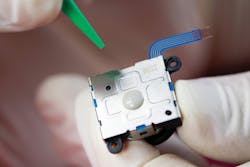Die Attach Epoxy Featuring High Tg Meets NASA Low Outgassing Requirements
Master Bond EP17HTDA-2 is a one component epoxy that can be used for bonding, sealing and die attachment. It is not premixed and frozen, and cures with heat. This dimensionally stable system features excellent mechanical properties with both a high modulus and die shear strength. It transfers heat and resists thermo-mechanical stresses effectively.
EP17HTDA-2 has exceptional temperature resistance with a service temperature range of -80°F to +600°F [-62°C to +316°C] and a Tg of 185-190°C. This compound has a thermal conductivity of 9-10 BTU•in/ft2•hr•°F [1.30-1.44 W/(m·K)], a low coefficient of thermal expansion, and is also electrically insulative with a volume resistivity greater than 1015 ohm-cm. It withstands a variety of chemicals including acids, bases, salts, fuels, oils, water and many solvents.
As a one part system, EP17HTDA-2 does not require any mixing and is curable in the temperature range of 300-350°F for around 4-5 hours. To optimize properties, a post cure of 2-3 hours at 400°F is recommended. It bonds well to a wide variety of substrates, such as metals, ceramics, plastics and composites. Upon curing, it delivers a tensile modulus exceeding 1,100,000 psi and a die shear strength of 20-23 kg-f at room temperature (2 x 2 mm [80 x 80 mil]). It also has minimal shrinkage upon curing.
While EP17HTDA-2 is well suited for electronic and related applications, it can also be used in vacuum situations as it passes NASA low outgassing testing. It is a thixotropic paste, yet is available in 10 cc and 30 cc syringes for automated dispensing, and has a shelf life of 3-6 months when stored at 40-50°F.
